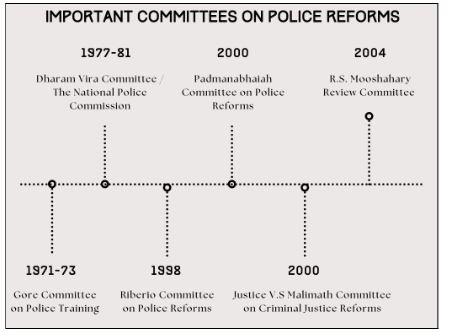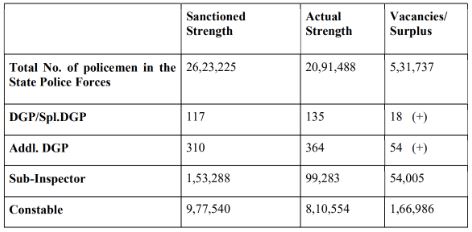The Parliamentary Standing Committee on Home Affairs recently submitted a report on ‘Police – Training, Modernisation and Reforms’. Among other things, the committee highlighted the tardy implementation of the police reforms as recommended by various committees, a high number of vacancies in the police force. Here is a review.
The genesis of rule of law and law enforcement lies in the social contract theories, propounded by early philosophers like Thomas Hobbes and John Locke. A mutual contract forms the base of the state’s authority to punish the lawbreakers. A state that cannot ensure control over law and order is often referred to as a ‘failed state’. Among many other forms of state’s authority over individuals of the society, policing is the most visible depiction. They are entrusted with the responsibility to ensure peace and tranquillity in society.
Each state has its own set of threats and challenges. Like other things, these also evolve and transform over time. This transformation is aided by the multiplicity of conditions like technological interventions, and socio-economic conditions to name a few. To combat these threats successfully, law enforcement agencies must also keep updating themselves. In India, the subject of ‘Public Order and ‘Police’ falls under the State List (entries 1 & 2 of List-II) in the Seventh Schedule of the Indian Constitution. As a result, the pace of reforms, if any, is not uniform across all states.
Traditional policing in India is caught in myriad problems, right from infrastructural aspects to budget allocations and then finally to reforms and modernization. Added to these is the negative perception of the police by the common citizenry. Recognizing the significance of reforms in the Indian policing system, we look at the pace of the proposed reforms. In this story, we track the implementation of the recommendations provided by various committees and commissions over time, for police reforms & modernization. The data for this brief is sourced from the ‘237th report on Police training, modernization and reforms’, as tabled in the Parliament by the standing committee on Home Affairs in February 2022.
Many committees, one goal – ‘Reform Policing’
Though ‘police’ and ‘public order’ fall under the state list, many states in India still follow the colonial-era Police Act, of 1861. Few states have come up with their own laws, while some made amendments to this existing act. But, with the changes happening around, this archaic law is proving to be insufficient in tackling newer challenges. These changes necessitate the need for modernization and reforms in the policing structure as well as the overall administration of law and order. The debate around the modernization dates to four decades, when, the first committee under Gore was formed for reforms in police training in 1971. This was followed by the ‘Dharam Vira Committee’, popularly known as ‘The National Police Commission (NPC)’ in 1977-81. This is the first-ever attempt at a thorough review of the police system with eight reports that covered a wide variety of issues surrounding the policing system.
This committee was then followed by Ribeiro Committee on Police Reforms. The major objectives of this committee were to look at the status of implementation of proposed reforms of NPC as well as to suggest any other recommendations that are necessary. The committee noted that both the Union as well as the state governments were lackadaisical in carrying out the suggested reforms. In addition to the recommendations of NPC, the Ribeiro Committee suggested the following modifications:
- Establishment of State Security Commission
- Establishment of District Police Complaints Authority
- Establishment of Police Establishment Board
The next committee was formed under the chairmanship of Padmanabhaiah. This committee was criticized for not holding any consultation with the public or civil society during its meetings. The committee, had discussed vide variety of issues, some of the major ones are:
- Control over Police
- Accountability of Police
- Politicization and Criminalization of Police
- Organized crime
- Federal offenses
This was followed by Justice V.S. Malimath Committee on criminal justice system reforms in 2000. The committee majorly focused on initiating reforms in criminal jurisprudence and making criminal and judicial procedures simpler. The last among the list of committees set up on police reforms was the R.S. Mooshahary Review Committee in 2004. The objective of this committee was to review the implementational status of recommendations of various committees on police reforms. The committee identified 49 major recommendations that were crucial to the policing reforms and modernization.
Below is the timeline of the committees set up on policing reforms, and a brief of the terms of reference, major topics covered, and the action taken by the government can be found here.

Financing Modernization and Police reforms:
As mentioned earlier, the ‘Police’ and ‘public order’ fall under the state list. The responsibility to modernize the forces and equip them with all resources to sufficiently address the latest emerging threats also lies with the State Governments. However, state governments have not been able to achieve this to the desired level. To prevent this from stalling the efforts to modernize the police, the Union Government had been supplementing the States with both finances as well as timely advisories. The financing part is taken care of by the scheme for Modernisation of State Polices Forces (MPF Scheme) from 1969-70. This was transformed into ‘Assistance to states for Modernization of Police’. It is a centrally sponsored scheme, where both states and centre contribute to a fixed ratio. The details of the allocation and release of funds to the MPF scheme from 2012 to 2020 are depicted in the chart below. This umbrella scheme is being extended from 2021-22 till 2025-26 with a total central financial outlay of Rs. 26,275 Crores.
Observation on recommendations:
Before moving on to recommendations, it is important to understand that not all recommendations provided are actionable. Some may be too general or too vague. The Mooshahary committee, while undertaking a review of the recommendations of the various committees, dealt with this aspect. Even among the actionable recommendations, some require action by the Union Government, while some require the same by the state governments or even by the department itself. A few recommendations could necessitate a legislative action or amendments to the existing rules, and some recommendations have financial implications. These categories can have overlapping.

Status of reforms
The parliamentary committee examined the status of implementation of 49 major recommendations identified by the Mooshahary Committee. 12 states and UTs have not furnished any information about the status of implementation of these 49 recommendations despite repeated instructions and advisories from the Ministry of Home Affairs. Only 24 states have provided updates regarding the same. We look at the status of implementation of some of the major recommendations. For the sake of clarity, the implementational status is divided into five categories. Each category is assigned a value for arriving at a proper mapping. It must be noted with utmost diligence that these values do not represent anything tangible but are only used to identify the category of the implementation status of a specific recommendation.
| Fully implemented | +2 |
| Partially implemented | +1 |
| Accepted but no action initiated | 0 |
| Under Consideration | -1 |
| Not agreed to | -2 |
Additional remarks by the Committee
Apart from looking at the status of the Implementation of the above reforms, the parliamentary committee also looked at other issues surrounding the policing system. Some of them are as below.
- Inadequacy of personnel: The committee stressed the importance of having an adequate number of personnel for the efficient functioning of the policing regime. The police personnel per lakh persons stands at 195.39 as per the sanctioned strength, and 155.78 as per the actual strength as per the data from the Bureau of Police Research and Development (BPR&D), as of 01 January 2020. There are no universal norms regarding this police-population ratio, as mentioned by the MHA in the parliament.

The committee felt that this quantum of vacancies is not desirable given the evolving trends of crime and security scenarios. It recommended the MHA actively push the states to conduct police recruitment drives and remove administrative bottlenecks if any.
- Low women in police forces: The Committee was informed by the Ministry that only 10.3% of the total actual strength of the police is women. The Committed expressed anguish at the dismal level of women’s police force and recommended the ministry advise the states to ensure that women’s police force adds up to 33% of the total police force. It also advised the states to establish at least one all-women police station in each district.
- Lower adoption rate of Model Police Act, 2006: The committee was concerned to note that even after 15 years of the distribution of the Model Police Act 2006, only 17 states/UTs have implemented it, either as it is or with necessary amendments. The committee instructed the ministry to obtain feedback from states for its non-adoption and advise them accordingly. This will ensure a uniform police structure across the country.
- Tackling Cyber-crimes: The committee also expressed concern with the exponential growth in cybercrime cases from 2018 to 2020. It clearly highlights the need for specialized training to deal with the increasing cybercrimes. Additionally, it also advised the ministry to consider the creation of volunteer groups of IT experts from civil society.

- Negative public image of Police: The committee expressed its displeasure over the negative perception created on the image of police across the country. Right training and shift from an entitlement-based approach to a rights-based approach would enable an attitude shift in the police personnel as well as the societal image towards police. The committee also emphasized the importance and need for stress management training for police personnel to ensure their mental and physical well-being and to enable them to function efficiently.
It is an undeniable fact that there is an immediate need for the holistic transformation of the policing regime in India. However, most of the transformation is focused on states rather than the benefactors- the common people. In addition, much of the modernization is heavily skewed towards materialistic upgradations rather than manpower skilling. Coupled with the above recommendations, these two aspects are also of utmost importance to ensure a holistic transformation of the administration of law and order.
Featured Image: Implementation of Police Reforms


